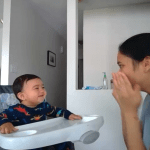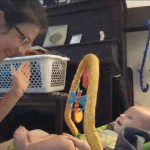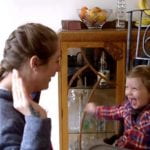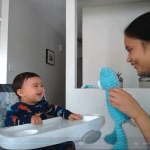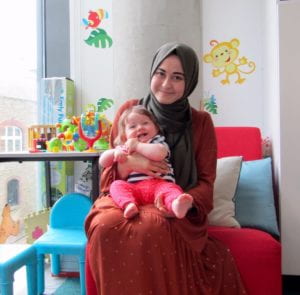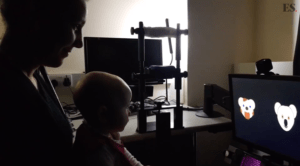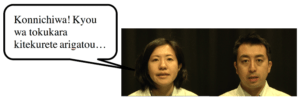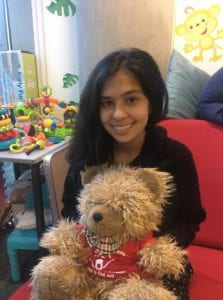How did a high school senior from New York end up designing a study of laughing babies with a research lab in London? How did I still manage to do original research despite the pandemic?
My name is Sophie Stumacher, and I am a high school student from Westchester, New York, just north of New York City. My school offers an intensive three year course, which helps guide students to complete an independent research project on a topic of their choice. One goal would be to experience real research and my project could also be entered in Science Fair competitions. But first I had to decide what science interested me.
Finding a topic
My interest in laughing babies was first sparked when I came across a textbook about developmental psychology. There was a three page chapter all about infant laughter. After I read it, I went straight to the nearest computer to do a quick Google search for “why do babies laugh?”. A few minutes later I realized something: no one knows the answer. From that moment on, I knew I wanted to pursue research in this topic.
My first step after picking a topic was to begin to read current literature, and eventually write a culminating review guide. I started reading journal articles in mid-November 2018, simultaneously writing my review guide until the end of February 2019. Mine ended up being a 43-page paper reviewing five articles that would enable me to familiarize myself with and show my understanding of the most current, important literature. Each student then independently reaches out to research professionals that would be willing to help guide the student through conducting a research project.
Finding a mentor
After reading a few of Dr. Addyman’s papers, I was excited to contact him at the end of March 2019, and delighted when he agreed to mentor me! Upon returning for my second year in the program, I looked for gaps in the literature that would lead to a possible study idea. By January 2020 I had come up with three potential studies ideas to share with Dr. Addyman. We decided to look into social laughter, and whether infants laugh more around people they know. This was based on Dr. Addyman’s previous study investigating the social laughter of toddlers who were already familiar, titled Social Facilitation of Laughter and Smiles in Preschool Children. In that study, all of the infants went to the same preschool, so they already knew each other. After reading it, I wondered, would the results have been different if the babies were strangers to each other? The idea for my original research was to analyze if the frequency of social laughter differs when the participant group is younger, as the original study included toddlers and not infants, and if the participants were joined with infants they had never met before.
Adapting for COVID-19
I continued to prepare for the research project, and began writing the start of my report. I talked with homestay companies and looked online for airplane tickets for a cross-Atlantic trip. However, because of travel restrictions due to the COVID-19 pandemic, all my plans came to a screeching halt. Dr. Addyman and I communicated weekly through Skype to redesign our research protocol. After several conversations about how we were going to adapt to me not being able to visit the lab, we decided that analyzing past data would be the best approach. Thankfully, Dr. Addyman was able to provide me with archival video data collected by him and his colleagues. These videos were first collected for a BBC documentary called the Babies: Their Wonderful World. My mentor and his colleagues initially collected video data from babies and their parents who performed five different jokes three times. They wished to investigate whether or not repetition had an impact on the frequency of laughter.
Jokes for babies
- peekaboo at 8 months
- peekaboo at 4 months
- Peekaboo at 18 months
- Not a cat at 8 months
After a creative Skype call, we agreed to look at the latency to laughter period, which indicates the time between the joke and the first instance of laughter. Furthermore, we wanted to test whether or not the latency period would be impacted because of age or joke type. The data that we used from the original study had a large variety of participants and five different jokes. Dr. Addyman and I decided to only test participants that fell within the range of six-to-eighteen months, and only three out of the five jokes. The two cohort ranges for age were the younger cohort (6-12 mos) and the older cohort (12-18 mos). Additionally, the three different joke types were conceptual, absurd, and uncategorized. The conceptual joke was a simple game of Peek-a-boo, the absurd joke was a game called Not-A-Hat, which consisted of an object other than a hat placed on the parents head and the parent exclaiming “Look at my new hat!”, and the last joke type, uncategorized, was a parent ripping a piece of paper in front of their child, which was called Tearing Paper.
What we found
Upon completion of the experiment we found that the older cohort ended up having a longer latency time, which was the opposite of what was expected. I initially believed that because the older infants would have more opportunities to understand laughter they would have a shorter latency time. In addition, the conceptual joke, or Peek-a-boo, had a significantly shorter latency time. This was expected, as infants that are older would hopefully have had more opportunities to experience humor. Although not all values resulted in statistical significance, there is still a great deal to be gleaned from the gathered data.
Investigating laughter and latency periods plays an important role in nurturing a well-established connection between parent and child. Attachment is considered the cornerstone of healthy emotional development in infancy and is related to a variety of long-term positive developmental outcomes. By improving understanding of latency, we can hopefully foster a more secure attachment between parent and child. As we continue to strengthen our understanding of infants, we come closer to finally figuring out just why an infant laughs, as well as the sheer importance of this behavior for the future.
What I learned
Overall, my time in the program my school offered, as well as the time I spent working with Dr. Addyman, was one of the most rewarding experiences I have ever had. I learned so many hard and soft skills ranging from developing confidence to communicate with a professional researcher, reading in depth and complex literature at a high school age, to improving my public speaking. Not only that, but I have now written both an intricate review guide and a report on a study of my own, which transformed my ability to effectively communicate science. More specifically, I used, with the help of Dr. Addyman, a video coding program called DataVyu and Jamovi, which is a statistical analysis program. On top of it all, I had to navigate adapting to a worldwide pandemic. I was both taught and learned so many valuable lessons and skills that I will only continue to improve and use in the future. I am exceptionally thankful and appreciative of Dr. Addyman and all of the time and help he provided me for two years. This experience was life changing, and I am hopeful that I will continue to do research in the future!
Sophie Stumacher, March 2021
We’re happy to report that Sophie’s project won the following awards:
- Westchester Rockland Junior Science and Humanities Symposium 2nd Place in Behavior
- Westchester Science and Engineering Fair 3rd Place in Behavioral & Social Sciences
Sophie was also a presenter at Harvard University’s International Youth Research Conference
You can see her presentation here:
